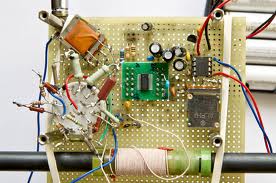Silicon Labs offers the industry’s broadest portfolio of clocks, buffers and oscillators for communications, computing, consumer, data center, wireless infrastructure and broadcast video applications. Leveraging patented CMEMS®, DSPLL® and MultiSynth technologies, these timing ICs eliminate the need for many expensive discrete components while improving performance, minimizing board space and simplifying system designs.
Silicon Laboratories has a range of in-circuit programmable CMOS clock generators with on-chip voltage-controlled crystal oscillators.
Unlike traditional clock generators that require a separate PLL to synthesize each non-integer related output frequency, the Si5350/51 devices will synthesise a different frequency on each of their eight output clocks.
The Si5350/51 generates system clocks up to 133MHz with 0 ppm frequency error.
The Si5350/51 can also simultaneously generate free-running clocks from a crystal input as well as clocks synchronized to a reference clock or analogue control voltage input, allowing multiple board-level timing domains to be clocked from a single device.
The aim, said the supplier, is to provide glitchless frequency shifting between two rates on up to six of the device outputs.
“This frequency shifting technique simplifies clock synthesis in audio and video applications, which often require a combination of frequencies to support multiple formats and display standards,” said the company.
It can also ease the problem of processor overclocking.
Silicon Laboratories has a range of in-circuit programmable CMOS clock generators with on-chip voltage-controlled crystal oscillators.
Unlike traditional clock generators that require a separate PLL to synthesize each non-integer related output frequency, the Si5350/51 devices will synthesise a different frequency on each of their eight output clocks.
The Si5350/51 generates system clocks up to 133MHz with 0 ppm frequency error.
The Si5350/51 can also simultaneously generate free-running clocks from a crystal input as well as clocks synchronized to a reference clock or analogue control voltage input, allowing multiple board-level timing domains to be clocked from a single device.
The aim, said the supplier, is to provide glitchless frequency shifting between two rates on up to six of the device outputs.
“This frequency shifting technique simplifies clock synthesis in audio and video applications, which often require a combination of frequencies to support multiple formats and display standards,” said the company.
It can also ease the problem of processor overclocking.
For more detail: In 8-channel clock IC siLabs uses on-chip crystal

